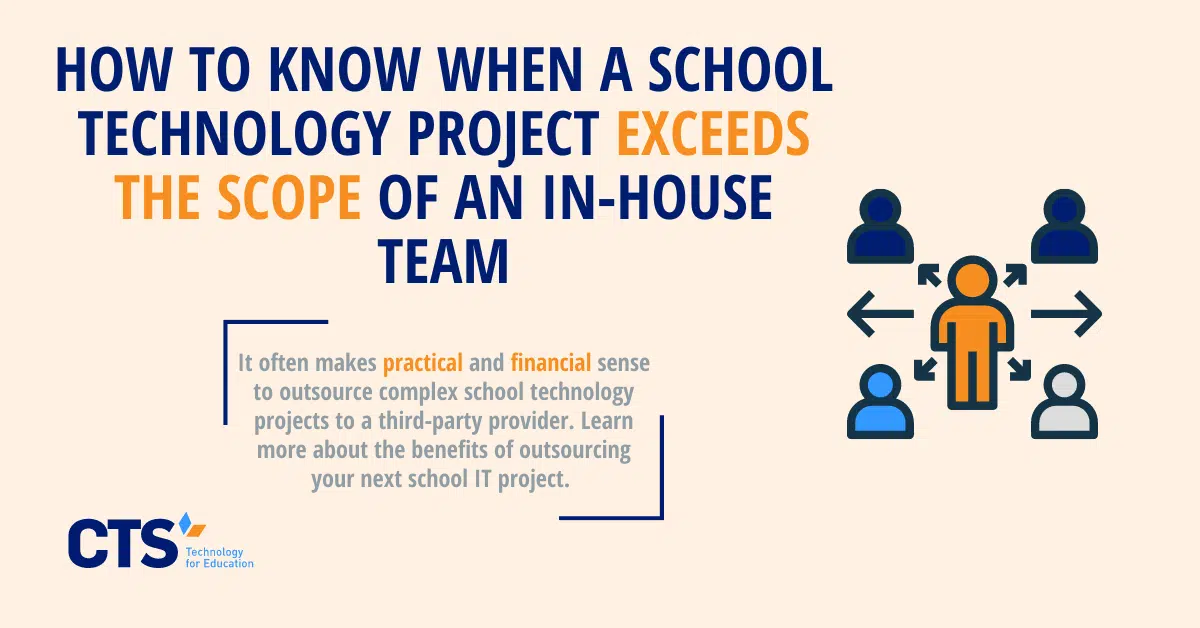Complex school IT projects might exceed the scope of an in-house team’s services.
School IT teams’ responsibilities run the gamut from day-to-day troubleshooting to complex school technology projects. Each part of their workflow is essential to both the short- and long-term health of the school. Day-to-day troubleshooting ensures that teachers, students, and administrators have the tools they need to accomplish their jobs, while longer-term projects can add significant value to school programming. For instance, updating a school’s wireless access points, scaling a 1:1 student-to-Chromebook ratio across the school, or replacing a school’s critical IT infrastructure all require tremendous time and energy. Still, they ultimately have sustained, positive impacts on student achievement.
But what happens when a complex school technology project exceeds the scope of an in-house team? For instance, what if the project requires hours and hours of time that the school IT team simply doesn’t have to spare? What if the project involves a piece of hardware or software with which the in-house team’s members don’t have much experience? Perhaps more commonly: what if the project is so complex and takes so much time that the school determines it’s prohibitively expensive? In each of these cases, it often makes sense to outsource the project to a third-party provider, one with both the know-how when it comes to the project specs and with an hourly- or project-based rate that won’t break the bank.
The in-house team might not have the technical knowledge required to tackle a complex school technology project.
It’s difficult to hire an in-house school IT team with the full breadth of knowledge required to run a school’s educational technology program. The needs of such a program are diverse: student Chromebooks, staff laptops, projectors, SMART boards, wireless access points, routers, switches, servers, and cybersecurity are just some of the items and topics the team must address. It can also be difficult to find team members who want to engage in day-to-day troubleshooting and also have the skills to execute longer-term strategic projects. A school IT team member, can be fixing a student’s Chromebook keyboard one minute and sitting in a board meeting discussing the next school year’s budget the next.
When a school IT project exceeds the technical knowledge of a school’s in-house team members, it often makes more sense to engage a third-party provider than to require the in-house team to “study up” to meet the project’s needs. Not only does the latter require significant time and energy from the in-house team’s members, but it also takes away valuable time from the team members’ daily responsibilities. Moreover, an in-house team member who recently learned about a particular piece of hardware or software might not be able to execute the project at the same level as a third-party provider with more experience.
It might be less expensive to outsource complex school technology projects.
Depending on the in-house IT team’s pay structure, it might be less expensive to hire a third-party provider to tackle a complex school technology project. For example, if an in-house team member is paid hourly, a complex school IT project might require them to work costly overtime hours that can quickly add up. Moreover, if the in-house team member lacks the technical skills for the job, he or she might have to spend additional time studying up to accomplish the project.
By contrast, contracting with a third-party provider gives the school a better sense of how much it can expect to pay for a project upfront. The school can select a provider it knows has done the exact project, or at least a similar one, previously, and can rest easy knowing the quoted project price falls within its budgetary constraints. Relying on an in-house team can feel like a school rolling the dice: if the project takes longer than expected, requires materials the school doesn’t have on hand, or ultimately requires the school to call in a third-party provider for one or more aspects of the project, costs can quickly add up, draining resources from other instructional or non-instructional priorities.
At CTS, we help schools tackle their most complex IT challenges so they can accomplish their unique missions.
Our team has worked with more than 60 schools across the United States to tackle their most complex school technology projects and accomplish their unique missions. While we provide top-to-bottom managed IT services for schools, we can also assist in-house teams with complex school technology projects on an as-needed basis. Our experience working in a diverse array of school settings equips our team members with the know-how required to successfully execute even the most complex of school technology projects. Contact us today to learn more about our services and how we can help your school accomplish its unique mission.




